Updated on: June 29, 2025
If you’ve ever wondered what it takes to drive for the United States Postal Service, you’re not alone. In 2025, logistics will form the core of every fast-scaling operation for delivery jobs. Especially mail carriers are getting fresh attention.
The USPS driver role is one of the few government-backed jobs that offer consistency, benefits, and the kind of structure gig drivers often wish they had.
So, if you’re looking to understand exactly how much USPS drivers earn, how the job works, and what it takes to get started, you’re in the right place.
We’ll find out how people land the role and what kind of hours we’re talking about.
How to Become a USPS Driver in 2025
There is no need for a logistics degree or a commercial trucking background to start delivering USPS packages.
What you do need is consistency, a clean record, and the willingness to follow protocol.
Here’s how it works.
Step 1: Meet the Basic Requirements
Before anything else, make sure you tick these boxes:
- Minimum age: 18 years
- Hold a valid state-issued driver’s license
- Pass a background check
- Clear a medical assessment that confirms you’re fit for duty.
These are the common prerequisites you must meet, as they ensure every USPS driver is ready to handle the responsibility of moving federal mail.
Step 2: Apply Through the Official Portal
All USPS jobs are listed on USPS Careers.
You need to search for roles like City Carrier Assistant (CCA) or Rural Carrier Associate (RCA) based on your location.
Once you apply:
- You’ll be scheduled for a road test
- There’s a need for you to pass the USPS Defensive Driving Course
- A thorough background screening and drug test will follow
Step 3: Know What Type of License You Need
For most city and rural routes, your regular driver’s license will work just fine.
However, if you’re applying for roles like:
- Motor Vehicle Operator (MVO)
- Tractor Trailer Operator (TTO)
Then, a Commercial Driver’s License (CDL) might be necessary. USPS typically looks for Class A or B for heavy vehicle operations.
USPS Driver Roles to Explore
Here’s a quick breakdown of the common driving jobs USPS offers:
- City Carrier Assistant (CCA): Delivers mail in urban areas, often on foot or using USPS vehicles
- Rural Carrier Associate (RCA): Covers routes in suburban and rural areas
- Motor Vehicle Operator (MVO): Drives larger postal vehicles within distribution networks
- Tractor Trailer Operator (TTO): Responsible for handling long-haul transport between regional USPS hubs
Each role plays a different part in the ecosystem, but all are essential to getting mail delivered on time.
How Much Does a USPS Driver Make in 2025?
Mail delivery may look simple from the outside, but USPS drivers hold a frontline role that keeps American neighborhoods and businesses connected. Beyond public service, these positions offer reliable income, federal benefits, and a predictable work structure.
Let’s get to the core: how much USPS drivers earn, from new hires to seasoned route carriers.

increase fuel savings
Save $200 on fuel, Monthly!
Optimize routes with our algorithm, reducing travel time and costs efficiently.
Get Started for Free
Average Annual and Hourly Pay (United States)
The national average for a USPS driver in 2025 sits between $42,000 and $56,000 per year, according to Ziprecruiter.
This range reflects full-time city and rural carriers with at least two years of experience. Drivers operating government-owned vehicles and handling high-volume deliveries tend to fall on the higher end of the pay spectrum.
Entry-Level Pay: What New Drivers Start With
New USPS drivers typically begin their journey in roles such as City Carrier Assistant (CCA) or Rural Carrier Associate (RCA).
Starting Pay
Most entry-level drivers earn between $19 and $21 per hour. Rural routes in low-density areas may begin closer to the lower end, while urban-heavy regions with complex delivery paths offer slightly more.
Path to Higher Pay
These roles are considered non-career positions initially.
However, USPS promotes from within. CCAs and RCAs who maintain consistent performance often secure full-time status within 12 to 24 months, leading to a boost in hourly wages and access to federal benefits.
Earning Potential Through Overtime
Working beyond the regular shift brings in additional income.
USPS drivers are often eligible for:
- Time-and-a-half after 8 hours a day or 40 hours a week
- Holiday pay differentials during federal holiday operations
- Weekend premium pay in select regions or during seasonal surges
According to feedback from current carriers on Glassdoor, overtime can increase annual take-home pay by as much as $5,000 to $10,000, especially during peak months like November and December.
Impact of Location on Pay
Wages fluctuate based on the cost of living and urban demand. For example:
- In California, drivers report average earnings closer to $27 per hour, particularly in San Francisco or Los Angeles.
- In Texas, average hourly pay remains around $19 to $31 for full-time routes.
- In rural Midwest states, such as Iowa or Nebraska, rates start lower but often include vehicle reimbursement or route mileage bonuses.
These variations allow USPS compensation to remain competitive with private delivery services in each region.
Beyond the Base Salary: What Else Comes With the Job
USPS drivers also receive:
- Health and dental insurance after a qualifying period
- Federal pension eligibility for full-time staff
- Paid leave, including sick days, vacation, and holidays
- Job security through union representation
While pay is important, many drivers cite the long-term stability and structured progression as a key reason to stay in the role.
Takeaway
Driving for USPS goes beyond dropping off mail. It’s about consistency, structure, and a pay scale that rewards time, effort, and route complexity.
While entry-level drivers may begin modestly, there’s real growth integrated into the system, from full-time upgrades to overtime boosts and strong federal benefits.
For many, it’s a career that brings financial reliability without the unpredictability of the gig economy. Add to that the support of a national institution, and it becomes clear why so many stay for the long run.

Are you a fleet owner?
Want to manage your drivers and deliveries easily?
Grow your business effortlessly with Zeo Routes Planner – optimize routes and manage multiple drivers with ease.

increase fuel savings
Save $200 on fuel, Monthly!
Optimize routes with our algorithm, reducing travel time and costs efficiently.
Get Started for Free




















